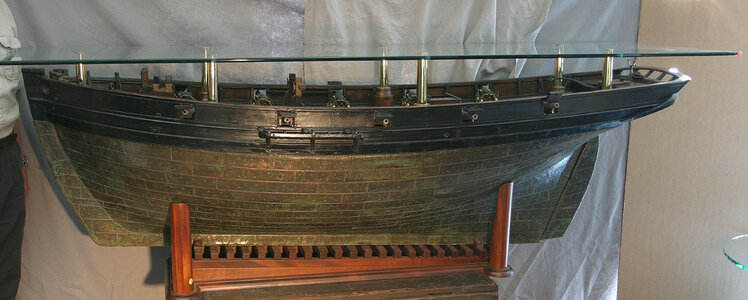Does anyone have a diagram of what the interior cross section of a Royal Navy cutter on the lines of a Lady Nelson or Sherbourne would look like? I was reading about Revenue cutters and one of the issues was that local crews and captains were sometimes not fast enough to intercept smugglers because they tried to avoid sleeping on board, preferring a cozy bed ashore. So I wondered how uncomfortable they were. Where and how arranged were the quarters? How big was the hold? Why dont they have a small boat to use to board the smuggling suspects' craft? Imagine if you were on one of these out with the fleet for a longer period. How would that have been. How did they cook? So many questions...
You are using an out of date browser. It may not display this or other websites correctly.
You should upgrade or use an alternative browser.
You should upgrade or use an alternative browser.
They were really small...... and they had 50 to 70 seamen on board
 collections.rmg.co.uk
collections.rmg.co.uk
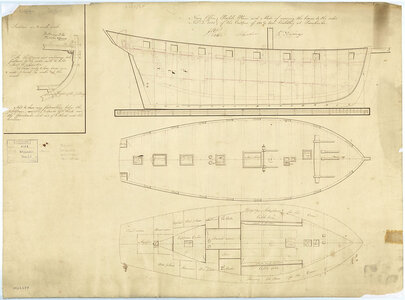
Scale: 1:48. Plan showing the inboard profile, upper deck, lower deck with platforms, and a section illustrating the fixing of beams to the sides, for 160 ton Cutters building at Pembroke Dockyard. This relates to Skylark (1821), a 10-gun Cutter; and possibly Swift (1821), a Revenue Cutter. Signed by Henry Peake [Surveyor of the Navy, 1806-1822], Joseph Tucker [Surveyor of the Navy, 1813-1831], and Robert Seppings [Surveyor of the Navy, 1813-1832]
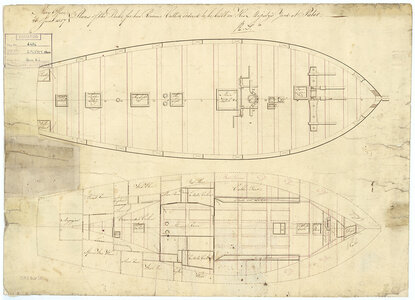
Scale: 1:48. Plan showing the upper deck, and lower deck with platforms for Snipe (1828) and Speedy (1828), two Revenue Cutters to be built at Pater [Pembroke Dockyard]. Initalled by Robert Seppings [Surveyor of the Navy, 1813-1832].
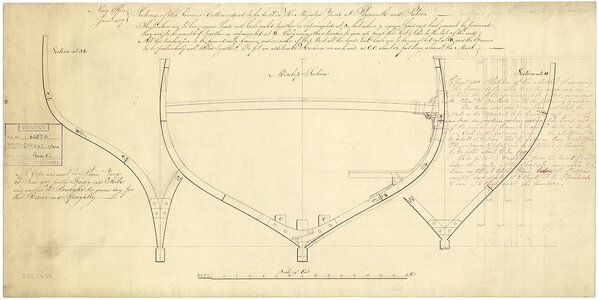
Scale: 1:48. Plan showing the sections at Station 14, Midship, and Station M, with pencil modifications and partial frame profile, for Revenue Cutters built at Plymouth Dockyard and Pater [Pembroke] Dockyard: Fancy (1817); Kite (1817); Racer (1818); and Sprightly (1818). Note: Plan was prepared from the Draught of the Lapwing (fl. 1816).
 collections.rmg.co.uk
collections.rmg.co.uk
Skylark (1821); possibly Swift (1821) | Royal Museums Greenwich

Scale: 1:48. Plan showing the inboard profile, upper deck, lower deck with platforms, and a section illustrating the fixing of beams to the sides, for 160 ton Cutters building at Pembroke Dockyard. This relates to Skylark (1821), a 10-gun Cutter; and possibly Swift (1821), a Revenue Cutter. Signed by Henry Peake [Surveyor of the Navy, 1806-1822], Joseph Tucker [Surveyor of the Navy, 1813-1831], and Robert Seppings [Surveyor of the Navy, 1813-1832]

Scale: 1:48. Plan showing the upper deck, and lower deck with platforms for Snipe (1828) and Speedy (1828), two Revenue Cutters to be built at Pater [Pembroke Dockyard]. Initalled by Robert Seppings [Surveyor of the Navy, 1813-1832].

Scale: 1:48. Plan showing the sections at Station 14, Midship, and Station M, with pencil modifications and partial frame profile, for Revenue Cutters built at Plymouth Dockyard and Pater [Pembroke] Dockyard: Fancy (1817); Kite (1817); Racer (1818); and Sprightly (1818). Note: Plan was prepared from the Draught of the Lapwing (fl. 1816).
Fancy (1817); Kite (1817); Racer (1818); Sprightly (1818) | Royal Museums Greenwich
Those plans are just what I was looking for. Thank you. In "Kings Cutters and Smugglers, 1750 - 1815(?)" they show a number of details of the interior of smugglers' cutters, but not the government and navy ones, and of course the civilian ones had much larger holds, not to mention false bulkheads, decks, etc. Thank you. I would try and get Peter Goodwin's book, but it is very expensive, quite a bit more than I paid for my model!
- Joined
- Feb 15, 2019
- Messages
- 279
- Points
- 168

Also, for greater details, see Peter Goodwin's book on the HMS Alert 1777, Conway 'Anatomy of a Ship' series. Belowdecks revenue cutters vary considerably but it's worth noting that when it came to building improvements and new considerations could deviate from the drafts. I too am interested in cutters, Peter's book is a 'must have'. His aim was to have a full size replica built. This in turn would lead to GRP versions being taken from the hull to produce a unique racing class of revenue cutters. Sadly the planning stages took so long that the interested boatyard owners either retired or ceased building.
I became aware of Peter's book but will have to wait for a more reasonably priced copy to appear on internet used book shops. Thanks for the additional information. I think I should add a small boat to the Lady Nelson. Many accounts of chasing smugglers includes a part where they put out the boat while they secure the mothership.
- Joined
- Feb 15, 2019
- Messages
- 279
- Points
- 168

I was stupid, Peter is a friend and offered me a copy years ago before I started building. I didn't accept it, I couldn't see what use I would have for it! When I did see the need I had to get one shipped from the States for £150!!!I became aware of Peter's book but will have to wait for a more reasonably priced copy to appear on internet used book shops. Thanks for the additional information. I think I should add a small boat to the Lady Nelson. Many accounts of chasing smugglers includes a part where they put out the boat while they secure the mothership.
Some authors see their excellent works on subjects of niche interest languish in the remainders tables in book stores. Others see theirs bid up on the used book market. Supply and demand rules supreme!
As I am at the point nkw of populating the forecastle area with bitts and pieces on my Lady Nelson cutter, I have to ask: what is the point of the forward-most gunports? They must let in a lot of sea water and you could never manhandled a cannon up there. Or are they of another purpose?
- Joined
- Feb 15, 2019
- Messages
- 279
- Points
- 168

Under sail they would be closed. When in pursuit they would manhandle and reposition guns to the bow chasers. Shipping water under battle conditions would depend on sea state and necessity.As I am at the point nkw of populating the forecastle area with bitts and pieces on my Lady Nelson cutter, I have to ask: what is the point of the forward-most gunports? They must let in a lot of sea water and you could never manhandled a cannon up there. Or are they of another purpose?
If you look at the period drawings posted above in this thread it shows the reason I am puzzled. There is simply no room evident on the plans as drawn for a carriage to fit in and fire at the bow, nor is there a pathway clear to roll one up there. You're seeing something I am not?Under sail they would be closed. When in pursuit they would manhandle and reposition guns to the bow chasers. Shipping water under battle conditions would depend on sea state and necessity.
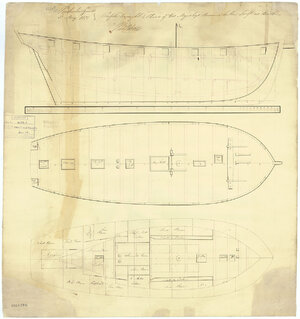
- Joined
- Feb 15, 2019
- Messages
- 279
- Points
- 168

The clearance around the winch varied, Surly had virtually no clearance and therefore no forward ports. Diligence, Swift and Bramble, and, earlier, Alert had about the same tight clearance and all had forward gun ports. Moving guns wasn't limited by these constraints however. A six pounder gun had a crew of 5 men, the barrel and trucks were only held by pins so the entire unit could be dismantled quickly. At 18cwt a gun this was no mean feat in itself! But, manhandling guns is what they did. In battle a gun free of it's tackle could travel the entire length of the deck in a rough sea. In the immortal words of Monty Python's Yorkshiremen "And you try telling that t'young folk today!
So these gunports had hinged lids? If so, did all the gunports?Under sail they would be closed. When in pursuit they would manhandle and reposition guns to the bow chasers. Shipping water under battle conditions would depend on sea state and necessity.
Should a cutter the size of Lady Nelson have a binnacle? Maybe at the back of the companionway ?
I think so! Binnacles have been in utilization since the 1700s. Binnacle is nothing more than a case\stand or later cylindrical container made of non-ferrous material that houses the different components of the navigations tools such as a magnetic compass to protect the delicate instruments.Should a cutter the size of Lady Nelson have a binnacle? Maybe at the back of the companionway ?
A ship binnacle is positioned right before the helmsman’s line of vision. The compass and all other navigation equipment are safeguarded within the binnacle, making it easy for the steersman to observe and steer the vessel accordingly. For this purpose, binnacles have always been constructed to come up to the waist of steersmen handling the vessel.
- Joined
- Feb 15, 2019
- Messages
- 279
- Points
- 168

Yes, in all the cutters I'm aware of. Modellship plans have a free download of Speedy (cutter, not brig) if you can manage to download them (I managed but had no luck recently, I think my pc is old and playing up)So these gunports had hinged lids? If so, did all the gunports?
Perfect. I will just add a 4x4mm, 12mm high post in front of the tiller starion to simulate that. Thanks for the input! The level of detail is limited on the model, but that would irk me if it were not there.
I just want to bump this question. Were there?So these gunports had hinged lids? If so, did all the gunports?
Wow, that's interesting. Thanks for the reply!
In my opinion not all cutters had lids - some yes and some notSo these gunports had hinged lids? If so, did all the gunports?
There are several contemporary models existing showing armed cutters (10 or 12 guns) without any lids at the gunports
f.e.
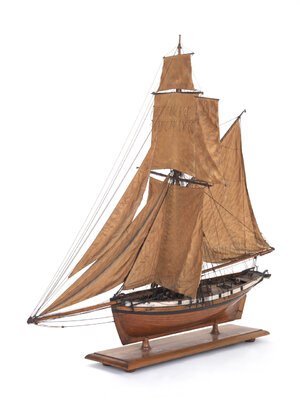
Scale: 1:32. A full hull model of a 10-gun cutter (circa 1800). The model is decked, equipped and rigged, with sails set. Cutters emerged around the middle of the 18th century as small, fast craft with a single mast. Originally used by smugglers, they were taken up by the revenue services and the Royal Navy. The earliest ones were clinker-built with overlapping planks, as in this example. A cutter usually had a very tall rig, with both fore and aft and square sails to use in different wind conditions. The model shows nearly all sails set, including the square topsail and topgallant and one topsail studding sail, which extends the sail area outward in light winds. It is not likely that they would all have been set at once in real life. The beam of the model is unusually narrow for a ship that would have to sail well with the wind on the beam. This suggests that the design was never executed, or that an amateur who did not have access to plans made it.
Warship; Cutter; 10 guns | Royal Museums Greenwich
The storage of the guns was a problem very often, due to the fact, that the available space on deck was limited.
If you have lids, you have to pull back the complete gun and store it on deck - only with this you have the possibility to close the lids.
Without lids, the guns were often pulled out (like ready for action) and fixed in this position (the muzzle was closed and secured against seawater with a cork
There were also hybrid lids possible - take a look at this contemporary model -> you can see here also the cork at the end of the muzzle
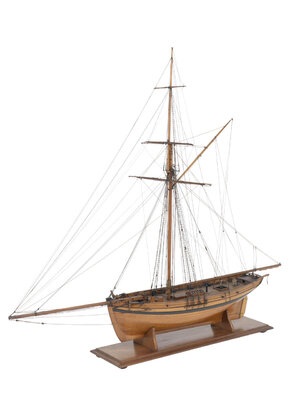
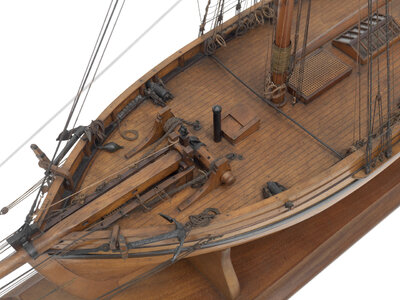
Scale: 1:24. A contemporary full hull plank on frame model of the armed cutter ‘Harriet’ (1843). The model is fully rigged with mast and spars, and the laid wooden deck complete with a windlass, a wheel carved from bone and stern davits. Measuring 61 feet in length by 19 feet in the beam, this vessel represents a design that would have been built during the late-18th century, as it is clinker built and still carrying the square topsail. Although the name ‘Harriet’ appears on the stern, the only vessel that appears to be similar is a revenue cutter, which operated from 1843 to 1860 and would have been carvel built.
BTW: Interesting to read here this sentence as part of the complete description of this model
The hull is pierced to carry 14 guns although there is only enough room on deck to operate 12 due to the position of the windlass and bowsprit forward.
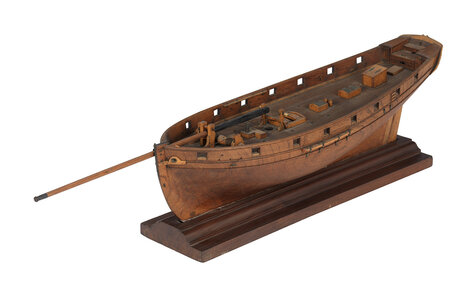
Scale: 1:72. A contemporary full hull model of an armed cutter dating from about 1822. The hull is carved from a solid piece of wood which has then been gauged out internally and decked over. The presence of a lead ballast keel would suggest that this model was made to float either as a design concept model for the lines, or as a sailing model for pleasure. It is complete with a variety of fittings including deck hatches, skylights and a companionway towards the after end of the stern to provide access to a cabin below. The hull is pierced to carry 14 guns although there is only enough room on deck to operate 12 due to the position of the windlass and bowsprit forward. At this scale, the length overall would be 68 feet by 24 feet in the beam. In the past and due the decoration on the stern, this model has been associated with a number of named vessels such as ‘Pelican’, ‘Dolphin’ and ‘Grecian’ but none of these match the dimensions of the hull. The date of 1822 is by no means certain although the carvel hull and the lack of a square topsail would suggest a date no earlier than 1820. Vessels of this type were operated both by the Royal Navy and the Revenue Service as they were very fast and could be handled by a relatively small crew.


